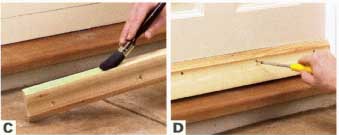Entry doors have to withstand outdoor elements of rain, wind, and changing temperatures, as well as the wear and tear of everyday life. They are stronger than interior doors, with impact-resistant materials and are finished to withstand the elements. Eventually a door dents or weather-stripping needs to be replaced. Below are some of the more common adjustments that you may need to make on your entry door. Keep in mind the material; you may need to take precautions for exotic woods versus manufactured products.
Tools and Supplies needed:
Basic tool kit and items on this page.
Maintaining and Repairing Doors
Over time you may notice that your entry door sticks, creaks, or does not close as easily as it did when it was first installed. Because a house is usually constructed from organic material, it's susceptible to wear and tear. In addition, wood expands and contracts through changing weather. Therefore, after your house has “settled” you may need to make simple adjustments to make sure your entry door is still plumb in the doorway and can easily open and shut. In addition to the natural changes that occur with an aging house, there are other factors that may make it necessary to spend time repairing your entry door. If your house sees a lot of foot traffic, your door is more likely to suffer from damage due to use.
Repairing a sticking entry door
If your door is sticking, you may need to adjust the size of the door to fit the entryway. It may be as easy as cleaning all of the hinges and removing any buildup of dirt along the door edges. The next step is to see if adjusting the hinges will alleviate the problem. Try tightening them, lithe door continues to stick, try sanding the edges of the door.
Repairing dents
Dents in entry doors can be repaired. If you have a steel door, you may be able to repair it using an auto filler. You will need to sand down the damaged area until you see the metal. The auto filler is then applied in layers until the door is smooth. This requires some sanding. When you have achieved a smooth surface, you can prime the area and paint it.
Squeaky hinges
If your door makes a squeak every time you open and shut it, you may need to lubricate your hinges with silicone. Remove the pin and lightly scrub the pin, barrel, and hinge leaves with steel wool. Then coat with a thin layer of silicone spray or a light penetrating oil.
Stopping air leaks
If you notice a cold draft around your entry door during the winter months, your door may need to be sealed. A few simple DIY tasks can help reduce your energy bills and keep your home a steady temperature. Check the caulk around the door, and replace it if it shows any damage or gaps. Weatherstripping is another option for stopping air leaks. Shown here is a weatherboard. Available in a variety of finishes, a weatherboard seals the bottom of the door. The angle of the weatherboard directs rain away from the bottom of the door.
Replacing a doorway
Remove one hinge screw and drive a 3-in (76-mm) screw into the framing to hold the door in place. Do not overdrive the screw, because you will move the door frame.
Installing a Weatherboard
A weatherboard can be installed into the doorframe or cut to fit against the frame’s profile. This decision often depends on the design of the door. If you choose to cut the weatherboard into the frame of the door, use an offcut section to draw a profile on the edge of the frame. The unwanted wood may then be removed, using a chisel.

A. At the base of the door, measure the distance between the stiles
of the frame. Cut the weatherboard to this length. B. Draw a line along
the top of the weatherboard. Predrill some holes in the front of
the board and countersink them.

C. Apply wood preservative to the underside of the board. Once dry,
apply wood adhesive along the back edge of the board.
D. Screw the board in place. Test by closing the door; plane off any
parts that catch the frame. Fill any holes, then sand and decorate
as required.
Replacing a Threshold
If you have an older home, it may be necessary to cut out a new threshold by sawing through the joint between the doorframe stiles and the top surface of the threshold. It should then be possible to ease it out of position.
- Apply wood preservative to all surfaces before installing them.
- Apply several coats to the underside because this can’t be accessed again once it has been installed.
- The new threshold may need to be cut to fit if you are installing a custom door of new side lites.